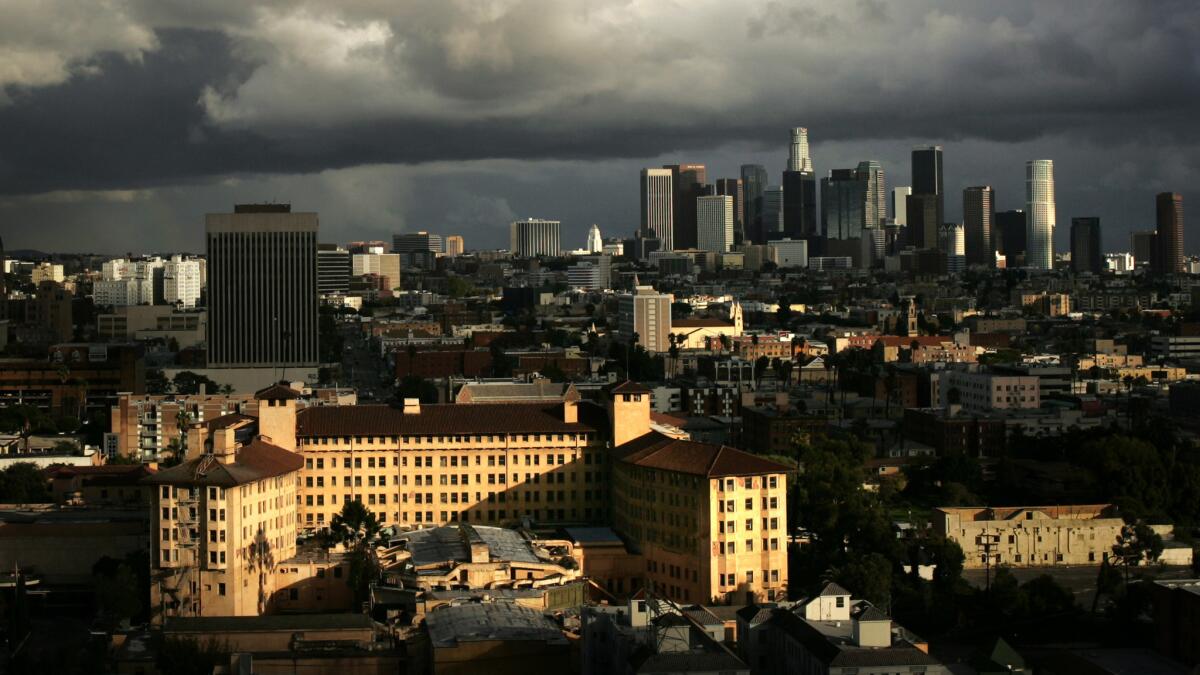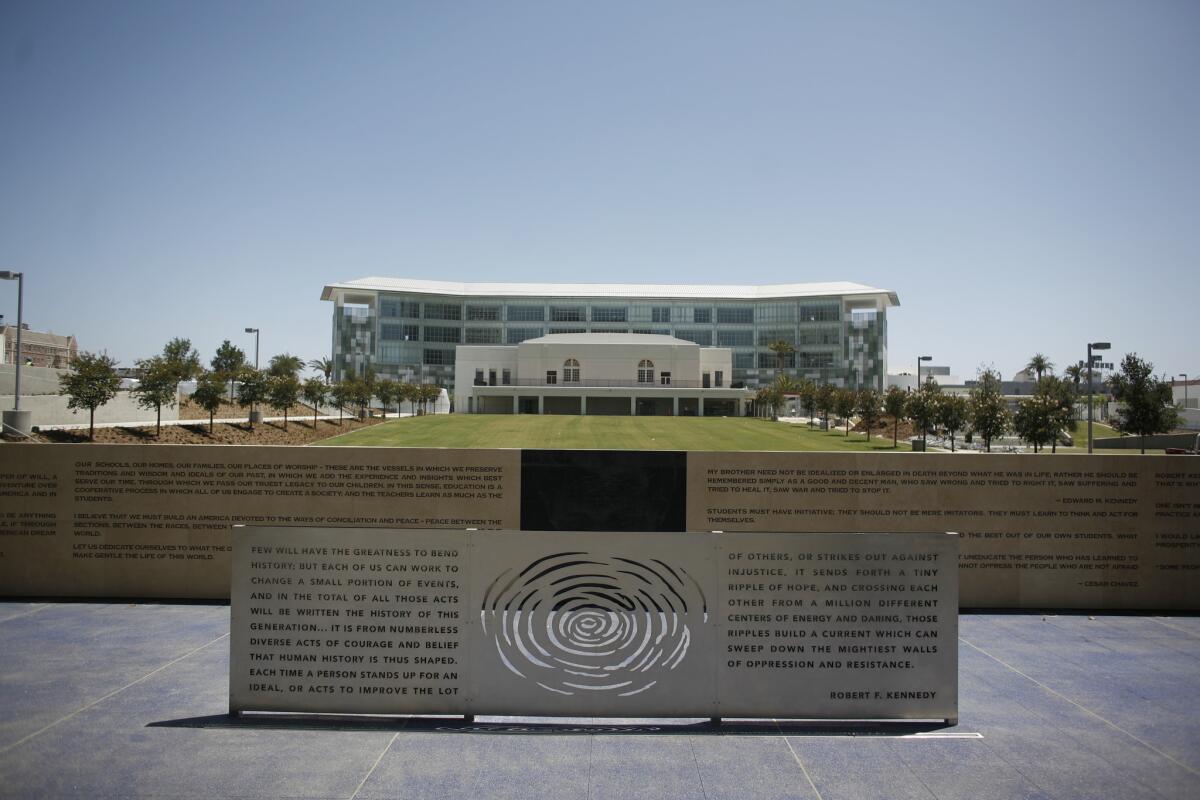In at least one huge deal in L.A., Trump got schooled

The Ambassador Hotel site, foreground, more than 23 acres near downtown Los Angeles, was bought by Trump Wilshire Associates in 1989. Now it’s an LAUSD campus.
On one side was the alpha male of New York developers who burst into town with pockets full of money, a legion of lobbyists and lawyers and an audacious plan to build the nation’s tallest building.
Opposing was a tag team Donald Trump would have little reason to fear: Jackie Goldberg and Jeff Horton, two rumpled progressives on the Los Angeles Board of Education.
Long before his run for president and his reality TV career as the ruthless boss, Trump fought an ugly decade-long battle over a Los Angeles landmark.
It’s not an exploit he’s bragging about on the campaign trail.
The prize was the Ambassador Hotel. A legendary Hollywood celebrity hangout and the site of the 1968 assassination of Sen. Robert F. Kennedy, it had endured a long downward spiral before closing in 1989.

Today a memorial to Robert F. Kennedy sits between Wilshire Boulevard and an LAUSD campus in Koreatown. This photograph was taken in 2010.
The 23.5-acre property, much of it open space, became a rare object of desire in a densely built part of the city.
The Board of Education already had its eye on the property for a badly needed high school when a Trump syndicate swooped it up for $64 million in 1989 and announced plans to erect a 125-story office tower.
The school board countered with a 7-0 vote to take the property from Trump via eminent domain.
Usually that would start a process in which the parties and their appraisers, or a court, would settle on a price.
But not when one of the parties was Trump.
His team launched a fierce lobbying campaign to block a $50-million state allocation to help the district buy the property.
Goldberg, then the president of the school board, took on the notoriously tough negotiator.
“They simply have enough money to buy enough lobbyists to go absolutely everywhere and talk to as many people as need to be talked to until they get what they want,” she said.
The district mounted its own lobbying effort and got the state allocation restored.
Talks on a possible sale price ensued but then broke down.
Roused by Goldberg, protesters outside the Ambassador chanted “Dump Trump” and carried signs saying, “Public need over private greed.”
Barbara Res, executive vice president for Trump Wilshire Associates, accused the board of “fiscal irresponsibility” for choosing to build a school on “some of the world’s most expensive property.”
The $73 million that the district was offering for 17 acres of the site was far below the developer’s estimate of its value — up to $200 million, she said.
The district, Res said, “will be embroiled for years in litigation it cannot win.”
Then Trump blinked.
In January 1991, he and his partners decided to take the nearly $48-million deposit the school board offered as part of its eminent domain condemnation suit.
In doing so, Trump Wilshire Associates, in effect, conceded the district’s right to take the property.
Attorney Rita J. Miller denied the widespread perception that the syndicate needed the money to deal with mounting financial problems. Miller said it was the district that had money trouble.
“Trump Wilshire Associates is confident the decision will be in the neighborhood of $200 million,” Miller said of the court case. “It would be totally irresponsible for the Los Angeles Unified School District to pay that amount for a school site.”
Two and a half years later, Goldberg had moved on to the Los Angeles City Council. Her former aide and successor, Horton, ratcheted up the pressure.
As the eminent domain suit was set to go to trial, the school board abruptly dropped its bid to buy the land. The recession had driven the property’s value down to $50 million, and Horton saw no reason to pay the previously estimated value of $74 million.
The Trump team’s arguments continued but began to sound overblown.
“We told them from the start they were going to wind up years down the road with no school for those kids, and that’s exactly how it’s working out,” Res said. “You tell me: Who’s the winner here?”
Res accused the district of duplicity, saying it reneged on a promise to pay $82 million for the entire 23.5-acre site “because they said politically it wasn’t a good idea.”
Horton discounted that, saying the offer was only “a potential deal that we didn’t accept, because we couldn’t figure out a way to pay for it.”
Early in 1994 a judge sided with the district.
“The district has treated us terribly and has been extremely cavalier about this,” Res said. She said Trump’s next step would be to sue the district for damages because it unfairly tied up the Wilshire corridor property. “We are going to end up with the lion’s share of the $48 million.”
But in December 1997, another judge ordered Trump to repay the $48 million deposit.
Although the Ambassador was once again its property to develop, the Trump partnership maintained that such an undertaking would no longer be financially feasible. Soon Trump, whose share was reported to be 20%, left the partnership with no signature building and little, if any, cash.
By then, Trump’s successor in the venture, Wilshire Center Marketplace, couldn’t return the deposit, having used the money to pay off debt.
The district sued to recover its deposit. The firm fought, claiming compensation for delays that had made the project untenable.
Join the conversation on Facebook >>
Again the court ruled in the district’s favor. At one point, the board ordered a sheriff’s sale, a move the owner forestalled by declaring bankruptcy.
The end of the story comes four years later when the district was flush with construction money.
The school board again voted to buy the Wilshire Boulevard property for a negotiated price of $76.5 million.
Today Robert F. Kennedy Community Schools, a kindergarten-through-12th-grade campus of standout architecture, is there.
But if Trump lost, the district didn’t entirely win. It would take nine more years before RFK opened, too late for more than a generation of students.
ALSO
Another rare sea serpent has washed ashore in Southern California
Female attackers are still few among Islamic extremist groups
Suspect fatally shot by police in Harbor-UCLA Medical Center emergency room, LAPD says
More to Read
Get the L.A. Times Politics newsletter
Deeply reported insights into legislation, politics and policy from Sacramento, Washington and beyond. In your inbox three times per week.
You may occasionally receive promotional content from the Los Angeles Times.











